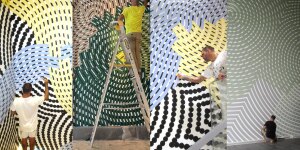
One of the Most Iconic Guitars of the MTV Era as Played by the most influential guitarist of his generation.
KRAMER’S ORIGINS WITH EDDIE VAN HALEN
Kramer CO176 is the first rear-loaded striped guitar that Eddie Van Halen received from Kramer luthier Paul Unkert. Unkert worked for Kramer in this key era of the early 1980s, and made the guitars for Eddie Van Halen, including the famous yellow and black double neck, the present guitar, and supplied the parts for the 5150 guitar that Eddie himself put together in Kramer’s workshop. Unkert was the main luthier in the Kramer shop at the time and did the detail work, contributed designs, and functioned as an artist relations rep.

CO176 is believed to have been completed in late 1982 and delivered to Eddie in January of 1983. It was made from poplar wood and was one of Eddie’s main guitars throughout 1983 and 1984 until Alan Holdsworth introduced Eddie to basswood (Holdsworth’s playing also heavily influenced Van Halen’s soloing at this time). Unkert made another similarly striped guitar (serial # B4129) from basswood in 1984 and this became Eddie’s choice of wood for guitar bodies going forward. Ultimately B4129 (identified by the 5150 white numbered designation behind the bridge) would become Eddie’s main guitar until he moved his endorsement to Music Man Guitars, circa 1990 (the Music Man guitars use Eddie’s 5150 as the model for the neck shape and radius, meaning that Unkert continued to influence guitar building for decades to come).
The famed red, white and black stripe paint on CO176 was the iconic Eddie Van Halen style that originally emerged from the original striped “Frankenstrat” (now at the Smithsonian) that he built in the 1970s, and this abstract design continued to define Van Halen’s look after the release of their album 1984. It’s legacy continues today, with 5150 homage guitars available today, but it was the present guitar, the precursor to the basswood 5150 that provides an important stage in Van Halen’s evolution of his guitars.

“1984 was a monumental breakthrough for Van Halen the band and Van Halen the guitarist. The album contained the most consistent set of material since their debut and broke new sales records for the group. That year Ed topped Guitar Player magazine’s Best Rock Guitarist poll for the fifth consecutive time, earning him a place in the publication’s “Gallery of the Greats.” “Thanks to Ed’s endorsement, Kramer guitars were selling as quickly as retailers could stock them, and Kramer added dozens of big names to its endorsement roster.”
Eruption, Brad Tolinski & Chris Gill, Hachette, 2021
THE HOT ROD GUITAR
In the 70s and 80s, a guitarist’s most obvious choices were between the two titans of Fender and Gibson. Fenders featured single coil pickups and were built on a principle of adaptability: all parts could be replaced fairly easily, including the innovative and pragmatic bolt-on neck.
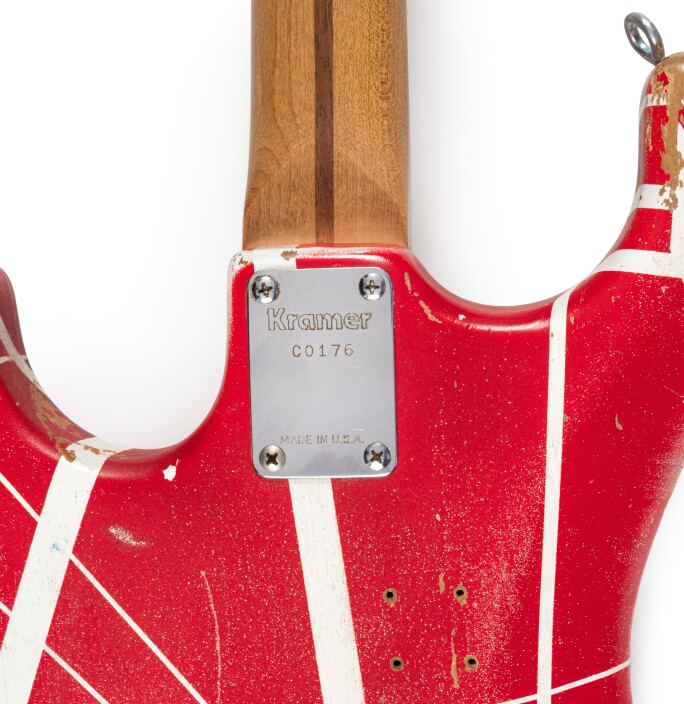
Gibsons were more robustly built and the fuller sound of humbuckingpickups. A player wanting aspects of one maker but not others had to modify an existing guitar or have a luthier make one from scratch. Eddie Van Halen is considered the first to bring this into a new era with his construction of the ”Frankenstrat.” This was not a modified guitar, but one built from parts, retaining mostly Fender characteristics but using Gibson-like electronics, most notably the humbucker.
Opening up the idea that electric guitars could evolve beyond their 1950’s origins, the “Frankenstrat” pointed the way to endless possibilities. These instruments allowed Eddie to shape his trademark “brown sound” and refine his fluid two-handed playing style that would define a generation of guitarists. A lover of vintage cars and an endless tinkerer, Eddie was not afraid to mod things until they suited his needs. Adjustments and selections covered all aspects of the guitar, including various scale lengths of the neck, neck profiles or nut widths, fret height, headstock angles, shielding electronics to try to tame hum and feedback, tuning machines, body sculpting for weight or design, all intentionally done to make the instrument most suitable to a specific style of playing.
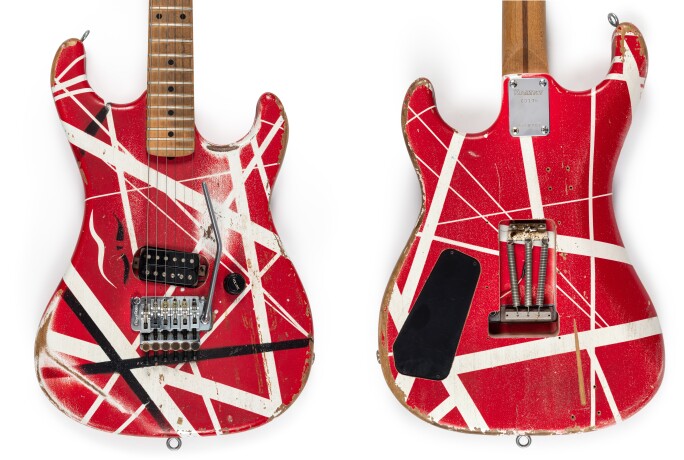
Eddie played all over the neck, fast, slow, hard and soft, and therefore low action and the perfect set up were critical. And while most instruments face routine maintenance and have parts replaced or fixed, this hot rodding was different. This wasn’t replacing the alternator when it broke, this was performance-enhancing optimization. Eddie was at the forefront of creating supercharged instruments for a new era of pyrotechnical players who emulated Paganini rather Les Paul or even Eric “Slowhand” Clapton (though Van Halen was a fan of both).
“Ed’s impact on the guitar world had by this time become incalculable. Besides being arguably the most innovative and most imitated guitarist on the planet, he’d also joined the ranks of the most influential guitar designers of his time.”
“A growing number of guitar manufacturers were shamelessly copying Ed’s minimalist single humbucking pickup/volume control–only/vibrato bar “super Strat” design, with some even having the unmitigated gall to rip off his signature striped graphics. He was “justifiably becoming angrier by the day as he watched others copy his ideas and rake in the dough. So, when the founding partner of Kramer Guitars, Dennis Berardi, approached Ed in February 1982 with a generous endorsement deal, the guitarist was ready to sign on the dotted line”
Eruption, Brad Tolinski & Chris Gill, Hachette, 2021
THE UNTHINKABLE BIRTH OF THE FRANENSTRAT
“With the release of the first Van Halen album, rock guitarists were exposed to the unthinkable: putting a Gibson-style humbucker pickup in a Strat shaped guitar. It was like two worlds colliding… the guts of a Gibson in a Fender-style body. By today’s standards, it’s not uncommon, but thirty years ago it was unheard of. My other guitar buddies and I stared at that album cover, looking at Eddie’s picture on the front, asking, ‘What the hell is that?’”
The race to build the better guitar began in LA with Wayne Charvel. “It was in this shop that a kid named Eddie Van Halen would sit on the floor and tinker with guitars while Charvel did his work. Charvel would eventually offer replacement bodies and necks made by his friend, Lynn Ellsworth. Ellsworth began making Strat bodies and necks under Charvel’s tutelage, and then started Boogie Bodies Guitars, a replacement guitar parts company. Charvel sold them at the repair shop.
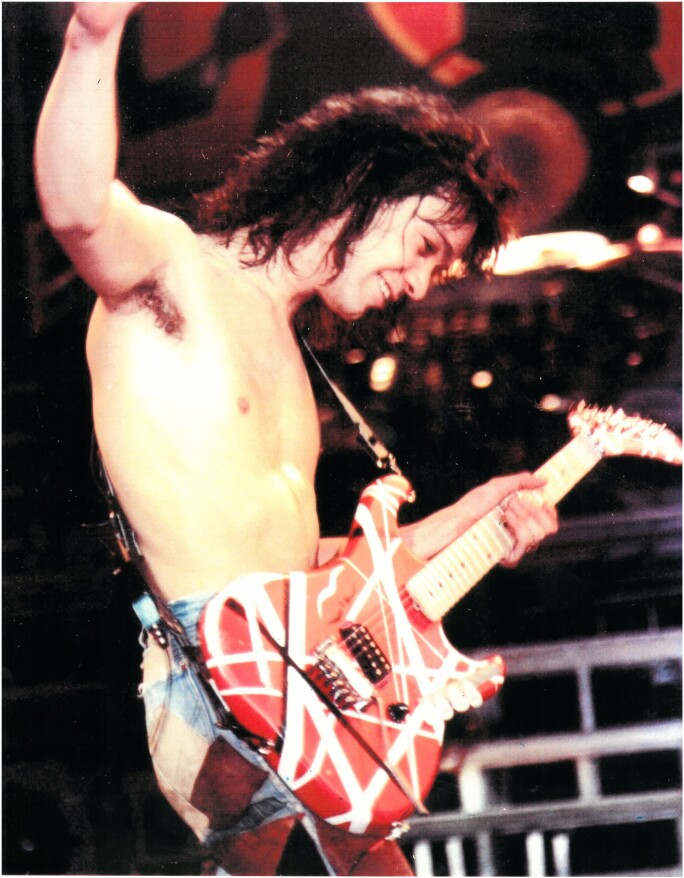
In the late seventies, Ellsworth would partner with Ken Warmoth to create Warmoth Guitar Parts. It was also during this time that Charvel did some work with Dave Schecter, who had begun to make aftermarket guitar parts. Together, they built necks and bodies to be sold through Charvel’s mail order service. Later, Schecter would go on to form Schecter Guitar Research, and would design high-end superstrats for discerning players. Eventually, Charvel began making bodies and necks on his own, as Ellsworth and Schecter took what they had learned from him and begin their own lucrative businesses” (ibid).
Charvel supplied guitars, and parts, to Eddie Van Halen, as well as some guitarists hot on his heels: Dokken’s George Lynch and Randy Rhoads of Ozzy Osborne’s band. By the mid 80s, Lynch was playing a Kramer, and Eddie soon followed. At the time, guitar maker Gary Kramer was based across the country, in New Jersey, and was working for Travis Bean. He started off making his own guitars as an offshoot of that company, but soon marketed his creations under his own name. With his partnership with music store owner Dennis Berardi he perfected production. Most of the accessories were completely designed by Kramer, and by 1983 they had settled on a Fender Strat-like shape called the “Pacer.” Eddie Van Halen appeared in a series of Pacer ads, with a bridge called the “Eddie Van Halen Tremolo.”
“It was during this time that a new contraption by a guitar tech named Floyd Rose entered the scene. It was a double-locking tremolo, much like the Rockinger, but it had a two-point floating pivot rather than the six-screw anchoring of the Rockinger. As Kramer continued to evolve, they discontinued the use of the Rockinger and began using the Floyd Rose tremolo, which was exclusive to all Kramer guitars by 1984. By then, Kramer had started adding other body shapes with exotic graphic paint jobs” (ibid).
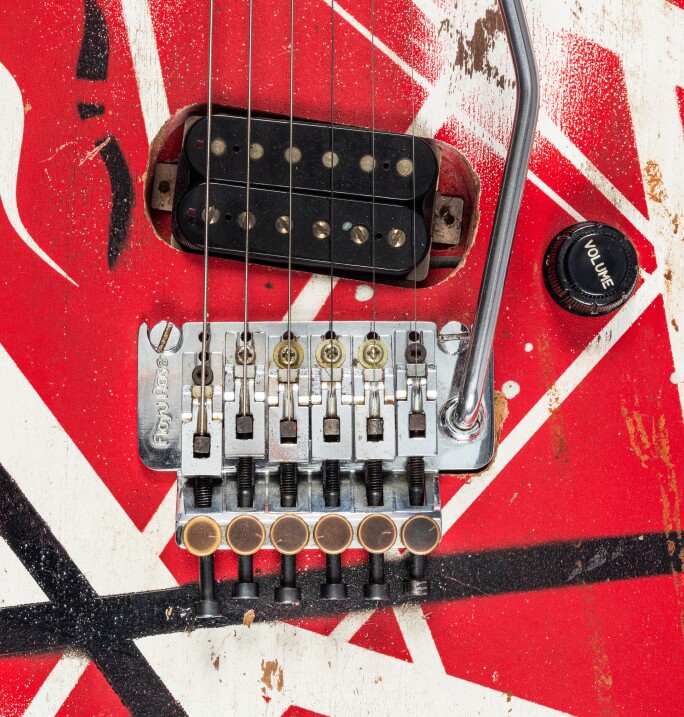
The Floyd Rose became the gold standard in floating bridge tremolos at the time, finally solving some of the inherent pitfalls of changes in tuning that plagued players. These allowed Van Halen to employ his famous “dive bomb” whammy bar techniques and have a hope of staying in tune during a lengthy performance. With the Eddie Van Halen endorsement, Kramers had entered the big leagues.
“In early February 1982, Kramer Guitars cofounder Dennis Berardi was flying to Anaheim, California, to attend a musical instrument industry convention, and, by happenstance, he was seated next to Van Halen’s tour manager. The two engaged in a friendly conversation about vibrato bar designs that inevitably led to a discussion about Ed himself, and the manager invited Berardi to meet Ed in LA.
“I didn’t know that much about Eddie Van Halen at that point,” Berardi said. “I knew he was a great guitar player, but I didn’t know anything about [the] guitars he played. He invited me into his house, and while I was sitting there, I saw his red, white, and black guitar. I took a closer look at it, and I was thinking, ‘What a “piece of shit!’ We started talking, and I told him how Gibson and Fender’s guitars were terrible, and they were ripping kids off. I told him that Kramer wanted to build really great guitars. Just like that he said, ‘All right, let’s do it. Let’s make Kramer number one!’ I asked if he wanted to endorse Kramer guitars and he agreed.
“Edward’s somewhat impulsive embrace of Kramer became official a few months later, in June, when the company announced the guitarist’s endorsement deal. Kramer wasted no time touting “The Edward Van Halen Tremolo,” a locking system developed by the German company Rockinger that was installed on a number of Kramer models. During his first meeting with Berardi, Ed agreed to endorse the Rockinger units, but he had second thoughts, because he personally preferred the Floyd Rose double-locking vibratos that he’d been using for a few years.Kramer wanted to keep Ed happy and told him that they were open to licensing the Floyd Rose system for their guitars—but that there was one huge impediment: the unit was prohibitively expensive to produce. At that time, Rose was still making them by hand, and installation required extensive guitar modifications.
"By appearing in numerous Kramer ads, performing at guitar trade shows, and playing his homemade guitars with Kramer logos placed strategically on the headstock on tour and in music videos, Ed significantly boosted the company’s image and sales, to the point where they became one of the leading guitar companies in the United States.”
“Edward’s endorsement deal with Kramer was an instant success and soon the money came pouring in. By appearing in numerous Kramer ads, performing at guitar trade shows, and playing his homemade guitars with Kramer logos placed strategically on the headstock on tour and in music videos, Ed significantly boosted the company’s image and sales, to the point where they became one of the leading guitar companies in the United States.”
Eruption, Brad Tolinski & Chris Gill, Hachette, 2021
EDWARD L. VAN HALEN, INVENTOR
CO176 originally contained an important innovation. Patent US4656917A was filed in 1985, and proved an important step for Eddie Van Halen in officially documenting all of his careful attention to modifying guitars and inventing not only new techniques for playing them, but new hardware for making them more player-friendly. With these innovations, players could tap into (pun intended) new methods of approaching the guitar. A classically-trained pianist as well as a guitar-god, Eddie approached the guitar’s fingerboard with a pianist’s eye, and his tapped passages, whether played in a conventional position or with the guitar tilted up and held on a stand that rested against his torso, are at the top of his stylistic attributes.
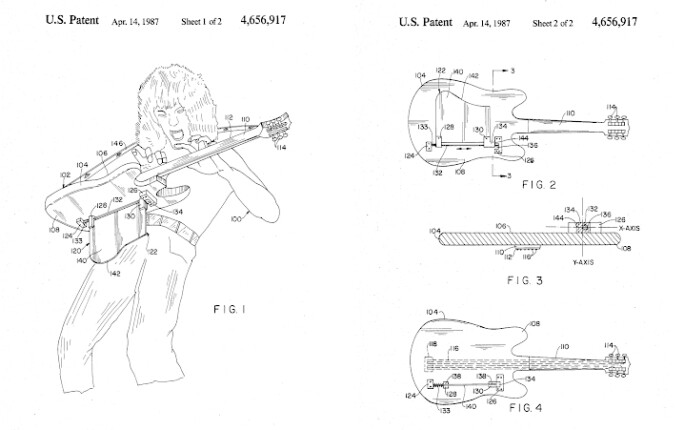
CO176 is the first of his guitars to include this support. The patent abstract describes it as: “A supporting device for stringed musical instruments, for example, guitars, banjos, mandolins and the like, is disclosed. The supporting device is constructed and arranged for supporting the musical instrument on the player to permit total freedom of the player's hands to play the instrument in a completely new way, thus allowing the player to create new techniques and sounds previously unknown to any player.”
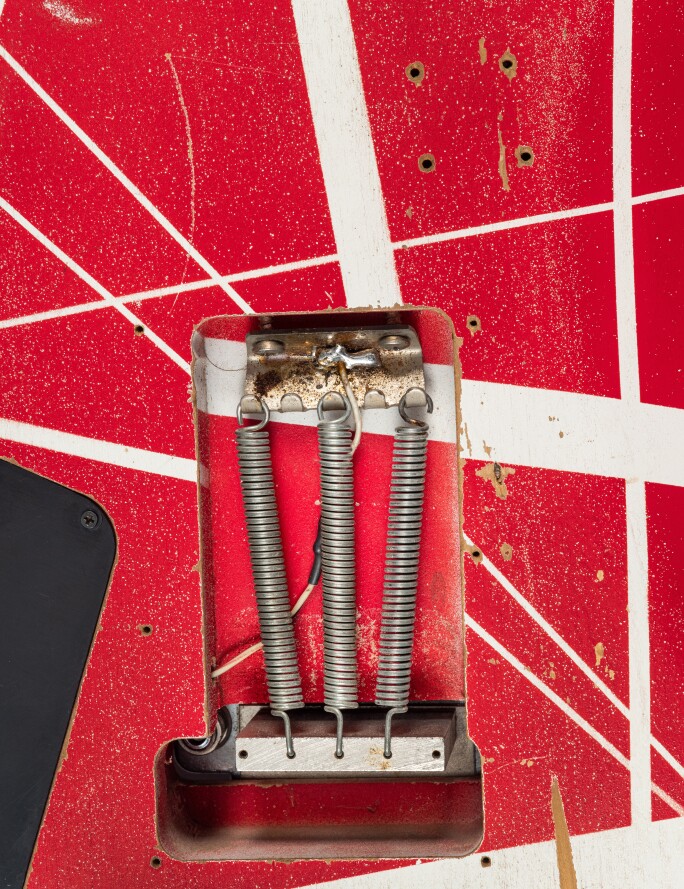
EDDIE AS GRAPHIC DESIGNER
Van Halen's design choices for CO176 were likely influenced by several factors. One of the main influences could be traced back to his early childhood in Holland and his exposure to the De Stijl art movement. This Dutch art movement, established in 1917 and spearheaded by painters Theo van Doesburg and Piet Mondrian, emphasized pure abstraction and universality by reducing compositions to essential elements of form and color. Their compositions most often feature vertical and horizontal lines and exclusively use black, white, and primary colors. The design of the Frankenstrat, featuring white, black, and red lines at sharp angles, bears a strong resemblance to the De Stijl style.
"But if you go look at these De Stijl paintings, you'll immediately get the vibe of Ed's guitar. So, to me, that was sort of a fascinating thing. Because Ed lived in Holland until he was seven or eight, there was no way he didn't see that as part of the Dutch culture – this painting and this art. So, I think some of the inspiration and aesthetic of that guitar just comes from that."
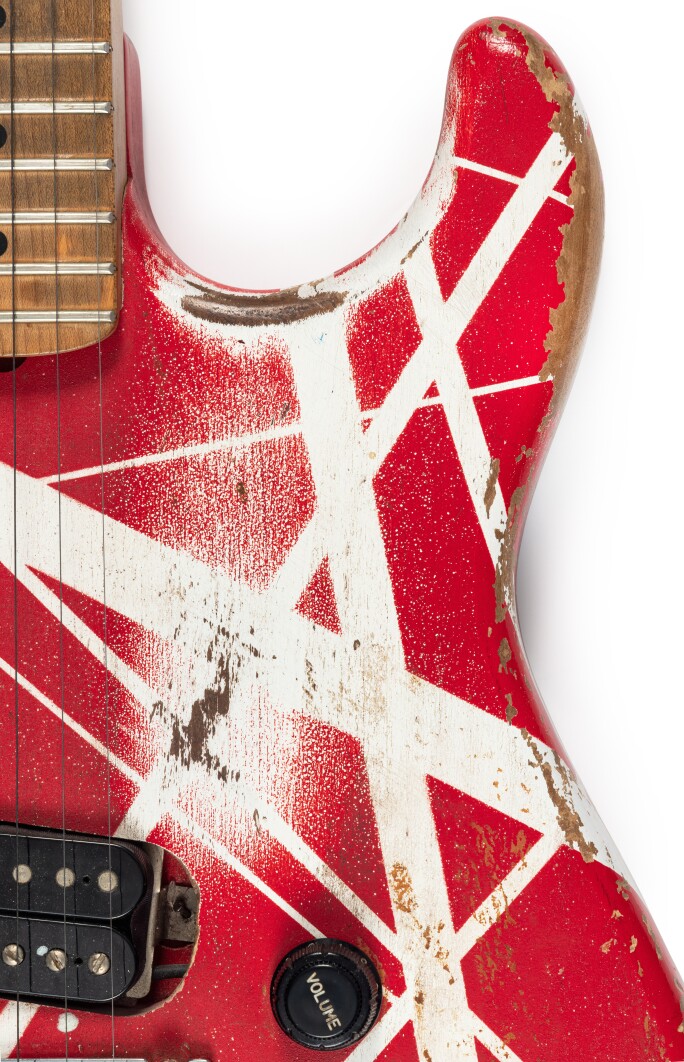
Van Halen’s move from Holland to Pasadena at eight years old certainly played a role in his design choice as well. There, he became immersed in Pasadena’s hot rod culture where many people worked on their cars themselves, often painting them with bright colors and modifying them with custom designs.
"I think another interesting and cool thing is that he grew up in Pasadena, right? Pasadena was a huge center for hot rods – for making hot rods and making custom cars. There were kids literally working on their front lawns with their cars – spray-painting hot rods, pinstriping them themselves. All kinds of things.
“And I think Ed, also – maybe not consciously – he was a car freak, so definitely he was aware of this. Maybe the whole notion of taking your guitar and 'hot rodding it,' and painting it and rearranging it…he would see these kids all over the place, taking their cars and modifying them – pulling out exhaust pipes and putting new ones in, or changing the tires or the engine, or repainting them. Doesn't that sound familiar to you? Doesn't that sound like what Ed was doing with his guitar? So, I can't help but think that in the whole process of creating your own guitar, it might have come from being exposed to the Pasadena and LA hot rod culture. I believe that there's something to do with that." Eruption, Brad Tolinski & Chris Gill, Hachette, 2021
“Maybe the whole notion of taking your guitar and 'hot rodding it,' and painting it and rearranging it…Doesn't that sound familiar to you? Doesn't that sound like what Ed was doing with his guitar?"
In the same way that hot rod enthusiasts would strip down and rebuild cars to make them faster and more visually striking, Van Halen approached his guitar as something that could be transformed and made unique. This DIY approach to guitar customization would become a hallmark of Van Halen's style, and it was one of the factors that set him apart from other guitarists of his generation. By taking a hands-on approach to his instrument, Van Halen was able to create a sound and a look that were entirely his own.
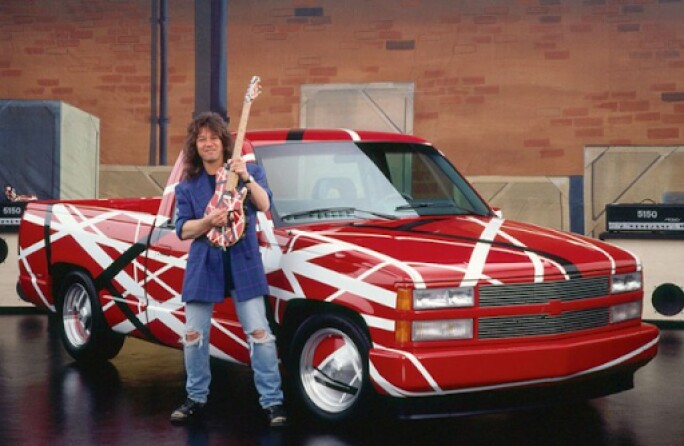
Beyond the cultural influences of Holland and Pasadena, the emergence of punk rock in the mid-70s may have served as a final source of inspiration for Van Halen. Van Halen and his friends became interested in punk rock early on, frequenting acts by bands in clubs around LA.
"You always hear that Ed said, 'Well, 'Ain't Talkin' 'Bout Love' was a tribute to our version of a punk rock song.' And they even went to I think it was the Whisky dressed up as punks one night. And there was this band playing at the time called the Dils. And the guitarist of the Dils [Chip Kinman] had a white Les Paul, and he decorated it with black electrical tape. If you see pictures of him and you see the guitar, you'll see it immediately as something that was not quite as interesting or as dimensional as what Ed did, but very similar. And Van Halen did see the Dils."Eruption, Brad Tolinski & Chris Gill, Hachette, 2021
LEAD GUITAR TAKES LEADING ROLE: THE ‘HOT FOR TEACHER’ VIDEO
Waldo, an awkward, Alfalfa-like child, nervously says goodbye to his overprotective mother and backs away from her into the steps of the school bus. He looks up at the bus driver, who turns out to be Van Halen lead singer David Lee Roth, staring behind sunglasses and sternly telling Waldo to go “si’ down!” Alex Van Halen’s signature double-bass drum leads off the song before Eddie peels down the fingerboard with a viscous pick slide, ushering in the song’s pyrotechnical low-register fingertapping – a growling frenzy of notes, classical in aspiration, pure rock in execution. We follow Waldo through his school day, in the class, in the library, his black-and-white depiction punctuated by technicolor moments of the band dancing on stage until Eddie finally cuts loose with one of the most iconic guitar solos captured in an 80s music video.
Knees bent, walking towards the camera, the headstock of his guitar seemingly inches from the camera lens, he’s coming right at us as he travels effortlessly up and down the neck, starting with rapid fire pick-work that lands him high up the neck before he settles back down by the nut for some forceful false harmonics and dazzling repeated licks. He’s on his knees, gazing at the fingerboard, open mouthed, before looking straight into the camera. Quick cut to color, the band dancing before him and then back to black-and-white, high register, low register, Eddie has ingeniously welded two interlocking solos, leaving no part of the guitar’s neck untraveled before backing into those power chords that welcome the vocals in again. The video ends with a humorous imagining of where the four band members ended up after school. Eddie? “Edward Van Halen is temporarily ‘relaxing’ in Bellevue Mental Ward and Making Progress.”
Van Halen - Hot For Teacher (Official Music Video)
-
 Contemporary ArtFinding Purpose in Art, Identity & the Ocean: In The Studio with Otis Hope Carey
Contemporary ArtFinding Purpose in Art, Identity & the Ocean: In The Studio with Otis Hope Carey -
 Sotheby's StoriesHow Jane Birkin's Original Hermès Birkin Bag Made History... Again | A Sotheby's Auction Story
Sotheby's StoriesHow Jane Birkin's Original Hermès Birkin Bag Made History... Again | A Sotheby's Auction Story -
 Handbags & FashionJane Birkin's Original Hermès Birkin Bag Shatters Auction Records at $10.1 Million | Sotheby's
Handbags & FashionJane Birkin's Original Hermès Birkin Bag Shatters Auction Records at $10.1 Million | Sotheby's
It was unheard of for a music video or song of the period to open with an athletic 30-second drum solo followed by a 30-second instrumental section, but that was Van Halen’s way. The video was directed by Pete Angelus and David Lee Roth, and it revels in its corny take on Waldo’s path through high school, but there’s no fooling around with Eddie’s playing. His guitar – always looking like an extension of him and not a tool he’s got ahold of – takes the starring role. CO176 is front, center, and everywhere, on screen and embedded in Van Halen lore.
With the original Frankenstrat now at the Smithsonian and other key EVH instruments retained by the family, the present is the most important and historic Van Halen instrument available to collectors.
Some Notable Provenanced Guitars and Their Prices:
- Eric Clapton “Blackie” Fender Stratocaster - $959,000 in 2004
- Bob Dylan’s “Newport” Sunburst Fender Stratocaster - $965,000 in 2013
- Jimi Hendrix 1968 White Fender Stratocaster - $2,000,000 in 1998
- Jerry Garcia’s “Wolf” by Doug Irwin - $1,900,000 in 2017
- David Gilmour’s Black Fender Stratocaster - $3,975,000 in 2019
- Kurt Cobain’s “Smells Like Teen Spirit” Fender Mustang - $4,550,000 in 2022
- Kurt Cobain’s “Unplugged” Martin D-18E - $6,010,000 in 2020
Provenance: Given by Eddie Van Halen circa 1990 to retiring Van Halen drum technician (and long time personal friend) Gregg Emerson. Emerson later gave the CO176 to his nephew, Joshua Box circa 1998. Box then sold the CO176 to Neals Music in Huntington Beach California. – Neals Music, sold to the present owner. The guitar comes with a letter by Paul Unkert and a signed photograph from Eddie stating "Is this your guitar or mine" in the iconic “Hot for Teacher” video.
